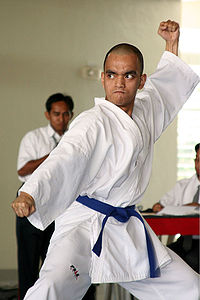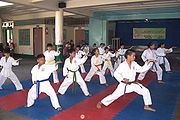
Karategi
Encyclopedia

Japanese language
is a language spoken by over 130 million people in Japan and in Japanese emigrant communities. It is a member of the Japonic language family, which has a number of proposed relationships with other languages, none of which has gained wide acceptance among historical linguists .Japanese is an...
name for the karate
Karate
is a martial art developed in the Ryukyu Islands in what is now Okinawa, Japan. It was developed from indigenous fighting methods called and Chinese kenpō. Karate is a striking art using punching, kicking, knee and elbow strikes, and open-handed techniques such as knife-hands. Grappling, locks,...
training uniform.
A karategi is somewhat similar to a judogi
Judogi
Judogi is the formal Japanese name for the traditional uniform used for Judo practice and competition. It is actually derived from traditional articles of Japanese clothing. Jigoro Kano derived the original judogi from the kimono and other Japanese garments around the turn of the 20th century, and...
(柔道着 or 柔道衣, Judo
Judo
is a modern martial art and combat sport created in Japan in 1882 by Jigoro Kano. Its most prominent feature is its competitive element, where the object is to either throw or takedown one's opponent to the ground, immobilize or otherwise subdue one's opponent with a grappling maneuver, or force an...
uniform) as it shares a common origin, however the material and cut of the uniform is generally much lighter and looser fitting. The heaviest of Karategi are only 16 oz compared to some judogi at 35 oz. Due to the nature of Karate training which emphasizes striking, kicking and a more limited range of standing throws compared to Judo the karategi has evolved in a manner that maximizes mobility and speed without the extremely coarse and strong fabric required for grappling and throwing found in Judo. They are made from smooth cotton which may be brushed or ribbed for unrestricted movement and added comfort. Reinforced stitching is common, as to compensate for the stresses put on the gi.
Inferior karategi are often cut from a light fabric similar to that of a summer shirt. These karategi are easily ripped, and tend to adhere to the practitioner's skin, creating some discomfort after any extensive perspiration is experienced. Such materials yield a karategi no heavier than the 8 oz..
Most quality karategi are cut from a light canvas style cloth because of its ability to stand up to considerable amounts of rigorous application and abuse without restricting the mobility of the karateka. Typically, such karategi weigh at least a 10 oz.
The weight of the material helps Karateka determine how rigid the suit will be. 12 or 14 oz cotton canvas is standard, although some manufacturers offer 16 oz materials. It is not unusual for a martial artist to feel better cooled when using a heavier karategi, compared to the cheaper karategi. Naturally, heavier suits will be more rigid. This rigidity increases ventilation within the suit. The heavier gi also has a more pronounced sound when a move is executed. Despite the extra weight of the heavier fabrics, most experienced practitioners prefer them due to their durability, and the ability of the thicker fabric to wick away perspiration.
The three main cuts of karate gi are Kata, European and Japanese. The Japanese cut has short sleeves and trousers for lest restriction. This cut also has a longer lapel that prevents it from riding up over the belt(obi). The Kata cut is very rare. It has even shorter sleeves and is chosen more for aesthetic appeal. European Cut has longer sleeves and trouser. The lapel is shorter. This cut again is chosen for aesthetic appeal. Karate uniforms come in a wide array of colours. Most Karateka still wear white. Some clubs use a system of differing colours to differentiate students from instructors.

Obi (sash)
is a sash for traditional Japanese dress, keikogi worn for Japanese martial arts, and a part of kimono outfits.The obi for men's kimono is rather narrow, wide at most, but a woman's formal obi can be wide and more than long. Nowadays, a woman's wide and decorative obi does not keep the kimono...
(belt) much longer than judoka and other martial artists.
Karategi are sometimes worn to practice other arts, such as jujutsu
Jujutsu
Jujutsu , also known as jujitsu, ju-jitsu, or Japanese jiu-jitsu, is a Japanese martial art and a method of close combat for defeating an armed and armored opponent in which one uses no weapon, or only a short weapon....
, when the practitioners are young and can expect to grow out of the gi in a few years; in this case, their reduced durability in comparison to judogi is less of a factor, and buying karategi until the practitioner stops growing is more cost-effective.
The karate gi appears to have been developed from the Judo uniform. When Gichin Funakoshi
Gichin Funakoshi
was the creator of Shotokan karate, perhaps the most widely known style of karate, and is attributed as being the 'father of modern karate.' Following the teachings of Anko Itosu, he was one of the Okinawan karate masters who introduced karate to the Japanese mainland in 1921...
demonstrated karate in Japan at the Kodokan
Kodokan
, or the Kodokan Institute, is the headquarters of the worldwide judo community. Literally, kō means "to lecture" or "to spread information," dō means "the way," and kan is "a public building or hall," together translating roughly as "a place for the study or promotion of the way." The Kodokan was...
, he still wore a traditional judo gi.
See also
- JudogiJudogiJudogi is the formal Japanese name for the traditional uniform used for Judo practice and competition. It is actually derived from traditional articles of Japanese clothing. Jigoro Kano derived the original judogi from the kimono and other Japanese garments around the turn of the 20th century, and...
(Judo uniform) - KarateKarateis a martial art developed in the Ryukyu Islands in what is now Okinawa, Japan. It was developed from indigenous fighting methods called and Chinese kenpō. Karate is a striking art using punching, kicking, knee and elbow strikes, and open-handed techniques such as knife-hands. Grappling, locks,...
- KeikogiKeikogior dōgi is a uniform for training, used in martial arts derived from Japan, or budō. . The prototype for the modern keikogi emerged in the late 19th century. The keikogi was developed by judo founder Kano Jigoro...
- Tokaido (company)
- Brazilian Jiu Jitsu Gi

